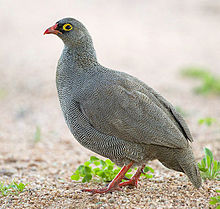The red-billed spurfowl (Pternistis adspersus), also known as the red-billed francolin, is a species of bird in the family Phasianidae. It is found in Southern Africa, including Angola, Botswana, Namibia, South Africa, Zambia, and Zimbabwe.
| Red-billed spurfowl | |
|---|---|

| |
| Adult bird and calls recorded in Namibia | |
| Scientific classification | |
| Domain: | Eukaryota |
| Kingdom: | Animalia |
| Phylum: | Chordata |
| Class: | Aves |
| Order: | Galliformes |
| Family: | Phasianidae |
| Genus: | Pternistis |
| Species: | P. adspersus
|
| Binomial name | |
| Pternistis adspersus (Waterhouse, 1838)
| |

| |
geographic distribution
| |
| Synonyms | |
| |
The species exhibits sexual dimorphism in size. Males are larger, measuring 38 cm (15 in) in length and weighing 340–635 g (12.0–22.4 oz), whereas females measure 33 cm (13 in) in length and weigh 340–549 g (12.0–19.4 oz). The species has barred underparts (in contrast to the related Natal spurfowl) and a conspicuous yellow eye-ring.[2]
Taxonomy
editThe red-billed spurfowl was described in 1838 by the English naturalist George Robert Waterhouse from specimens collected by James Edward Alexander on his expedition to Namaqualand and Damaraland. Waterhouse coined the binomial name Francolinus adspersus and noted that the specimens had come near the Fish River in what is now Namibia.[3] The specific epithet adspersus is Latin for "sprinkling".[4] The species is now placed in the genus Pternistis that was introduced by the German naturalist Johann Georg Wagler in 1832.[5][6] The red-billed spurfowl is considered as monotypic: the proposed subspecies mesicus is not recognised.[6]
References
edit- ^ BirdLife International (2016). "Pternistis adspersus". IUCN Red List of Threatened Species. 2016: e.T22678819A92790026. doi:10.2305/IUCN.UK.2016-3.RLTS.T22678819A92790026.en. Retrieved 16 November 2021.
- ^ McGowan, P.J.K. & Kirwan, G.M. (2017). Red-billed Francolin (Pternistis adspersus). In: del Hoyo, J., Elliott, A., Sargatal, J., Christie, D.A. & de Juana, E. (eds.). Handbook of the Birds of the World Alive. Lynx Edicions, Barcelona. (retrieved from http://www.hbw.com/node/53412 on 22 May 2017).
- ^ Alexander, James Edward (1838). "Appendix 1: Notice of the objects of natural history collected during the expedition". An Expedition of Discovery into the Interior of Africa : Through the Hitherto Undescribed Countries of the Great Namaquas, Boschmans, and Hill Damaras. Vol. 2. London: Henry Colburn. pp. 259-275 [267].
- ^ Jobling, James A. (2010). The Helm Dictionary of Scientific Bird Names. London: Christopher Helm. p. 32. ISBN 978-1-4081-2501-4.
- ^ Wagler, Johann Georg (1832). "Neue Sippen und Gattungen der Säugthiere und Vögel". Isis von Oken (in German and Latin). cols 1218–1235 [1229].
- ^ a b Gill, Frank; Donsker, David; Rasmussen, Pamela, eds. (2020). "Pheasants, partridges, francolins". IOC World Bird List Version 10.1. International Ornithologists' Union. Retrieved 14 February 2020.
External links
edit- (Red-billed spurfowl = ) red-billed francolin - Species text in The Atlas of Southern African Birds
- Xeno-canto: audio recordings of the red-billed spurfowl
